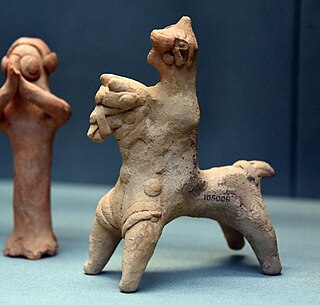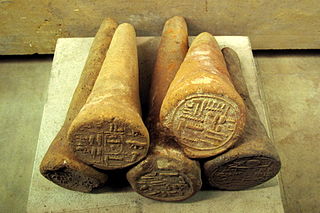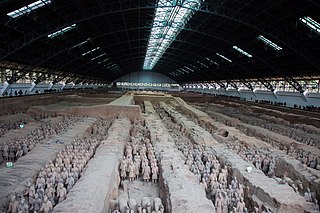 W
WThe Apollo of Veii is a life-size painted terracotta Etruscan statue of Apollo (Aplu), designed to be placed at the highest part of a temple. The statue was discovered in the Portonaccio sanctuary of ancient Veii, in what is now central Italy, and dates from c. 510 - 500 BC. It was created in the so-called "international" Ionic or late-archaic Etruscan style.
 W
WBankura horse is the terracotta horse, produced in Panchmura village in Bankura district in the Indian state of West Bengal. It has been praised for “its elegant stance and unique abstraction of basic values.” Originally used for village rituals, it now adorns drawing rooms across the world as symbols of Indian folk-art. It is the logo of All India Handicrafts.
 W
WBust of Hercules is a terracotta sculpture by Lucas Faydherbe (1617–1619) and makes part of the Van Herck Collection acquired by the King Baudouin Foundation in 1966.
 W
WCampana reliefs are Ancient Roman terracotta reliefs made from the middle of the first century BC until the first half of the second century AD. They are named after the Italian collector Giampietro Campana, who first published these reliefs (1842).
 W
WCharity with Four Children is a sculpture by the Italian artist Gian Lorenzo Bernini. Executed between 1627 and 1628, the work is housed in the Vatican Museums in Vatican City. The small terracotta sculpture represents Charity breast-feeding a child, with three other children playing. There is an imprint of Bernini's thumbprint in the clay.
 W
WThe Environment Triptych, by sculptor Jon Edgar, is a group of three portrait heads of environmental thinkers of the day. First assembled in 2008, it is composed of the terracotta heads of James Lovelock, proposer of the Gaia hypothesis, moral philosopher Mary Midgley, and writer Richard Mabey. Edgar worked with three in either Cornwall, Newcastle upon Tyne or Norfolk during visits in 2006 and 2007.
 W
WThe Euphrates Handmade Syrian Horses and Riders are zoomorphic clay figurines representing both solely horses or horses provided with riders and dating from the late Iron Age period. These figurines are produced in the Middle Euphrates region and they belong to a production comprehending some anthropomorphic specimens, i.e. the Euphrates Syrian Pillar Figurines (EU_SPF's).
 W
WThe Euphrates Syrian Pillar Figurines are anthropomorphic clay figurines dating from the late Iron Age period and produced in the Middle Euphrates region. These figurines are part of a greater coroplastic production mainly composed of handmade horse-rider figurines, i.e. the Euphrates Handmade Syrian Horses and Riders (EU_HSHR's).
 W
WField (1991) is a sculpture by British artist Antony Gormley. It consists of approx. 35,000 individual terracotta figures, each between 8 and 26 cm high, installed on the floor of a room facing the viewer. The figures were sculpted in Cholula, Mexico by about 60 members of a Texca family of brickmakers, under the supervision of the artist. The sculpture received a lot of media attention upon its first display, and many affectionate parodies.
 W
WFunerary cones were small cones made from clay that were used in ancient Egypt, almost exclusively in the Theban Necropolis. The items were placed over the entrance of the chapel of a tomb. Early examples have been found from the Eleventh Dynasty. However, they are generally undecorated. During the New Kingdom, the cones were smaller in size and inscribed in hieroglyphs with the title and name of the tomb owner, often with a short prayer. The exact purpose of the cones is unknown, but hypotheses exist that they variously served as passports, architectural features, and symbolic offerings, among others.
 W
WThe Huldschinsky Madonna is a c.1410-1430 terracotta sculpture. It is attributed to Donatello, an attribution based on the structure of the drapery, which is no longer simply a means of expression and decoration as in Gothic art but is instead more naturalistic and observed from life, following a strict dialogue with the anatomical forms beneath it and obeying the rules of gravity. The work's attention to detail such as the fringes on the clothing also recalls the artist's other works such as David. It has been in the Bode-Museum in Berlin since being donated by Oscar Huldschinsky in 1892.
 W
WChinese imperial roof decorations or roof charms or roof-figures or "walking beasts" or "crouching beasts" were statuettes placed along the ridge line of official buildings of the Chinese empire. Only official buildings were permitted to use such roof decorations.
 W
WThe Lydenburg Heads refer to seven terracotta heads that were discovered in association with other pottery artefacts in Lydenburg, Mpumalanga, South Africa. They are among the oldest known African Iron Age artworks from South of the equator. Other artefacts found in association with these heads include ceramic vessels, iron and copper beads, and bone fragments. Charcoal associated with the heads was radiocarbon dated, and this relative dating technique places these artefacts and the site at around 1410 BP, which constitutes one of the earliest dates for an Iron Age settlement in South Africa. The heads are hollow with thin clay strips added to create facial details. The skill and thought that went into the designs suggest that they were valued products of a well organized and settled community.
 W
WMadonna and Child is a c. 1440 painted terracotta relief of the Madonna and Child by Donatello, now in the Louvre.
 W
WMadonna and Child with Four Cherubs is a c.1440 terracotta sculpture by Donatello, now in the Bode-Museum in Berlin, which bought it in 1888. Still partly medieval in its iconography, Mary and Jesus' heads touch in a manner also seen in the artist's Pazzi Madonna. The work was badly damaged in the 1945 fire, with breaks in several places and losing its traces of polychromy.
 W
WThe Piot Madonna is a c.1440 or c.1460 sculptural roundel by Donatello in stiacciato. It is in the Louvre after being donated to that museum in 1890 by Eugène Piot, after whom it is named.
 W
WThe Standing Youth is a terracotta Tanagra figurine in the Staatliche Antikensammlungen in Munich with the inventory numbery SL 162, which was formerly part the collection of James Loeb. The red-brown clay statuette measures 30.7 cm high and was created around 325-300 BC in Boeotia.
 W
WTang dynasty tomb figures are pottery figures of people and animals made in the Tang dynasty of China (618–906) as grave goods to be placed in tombs. There was a belief that the figures represented would become available for the service of the deceased in the afterlife. The figures are made of moulded earthenware with colour generally being added, though often not over the whole figure, or in naturalistic places. Where the colouring was in paint it has often not survived, but in many cases it was in sancai ("three-colour") ceramic glaze, which has generally lasted well.
 W
WStanding Horse is a tomb figure created during the Tang dynasty in China. In ancient China, numerous tomb figurines and other artefacts were designed specifically to be buried with the deceased in large burial mounds. This large figurine features the use of Sancai, a glazing technique popular during the Tang dynasty.
 W
WThe Terracotta Army is a collection of terracotta sculptures depicting the armies of Qin Shi Huang, the first Emperor of China. It is a form of funerary art buried with the emperor in 210–209 BCE with the purpose of protecting the emperor in his afterlife.
 W
WTorso of Adele is an 1878-1884 sculpture by the French artist Auguste Rodin, originally modelled in plaster before being worked in terracotta. Judith Cladel states that it arose from his study of caryatids. The model was probably the Italian Adèle Abruzzesi, one of Rodin's favourite models. The sculpture was only completed in 1889 by the addition of the legs and left arm, for use in the top left-hand corner of The Gates of Hell. It does not appear in William Elborne's 1887 photographs of The Gates and so Rodin probably added it later. He also used the same torso, with a head added, for the female figures in Eternal Springtime and Illusions Received by the Earth.
 W
WThe Venus of Dolní Věstonice is a Venus figurine, a ceramic statuette of a nude female figure dated to 29,000–25,000 BCE. It was found at the Paleolithic site Dolní Věstonice in the Moravian basin south of Brno, in the base of Děvín Mountain, 549 metres (1,801 ft). This figurine and a few others from locations nearby are the oldest known ceramic articles in the world.
 W
WThe Vertault relief is a Roman relief from Vertault, the ancient Vertillum, in the Department of Côte-d'Or. Today it is located at the Museum of Châtillon-sur-Seine.
 W
WA set of life-size glazed pottery sculptures of luohans usually assigned to the period of the Liao dynasty (907–1125) was discovered in caves at I Chou in Yi xian or Yi County, Hebei, south of Beijing, before World War I. They have been described as "one of the most important groups of ceramic sculpture in the world." They reached the international art market, and were bought for Western collections. At least eight statues were originally found, including one large fragment which was long thought to have been destroyed in Berlin during World War II, but has been sighted in Russia recently.